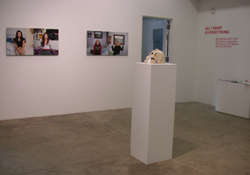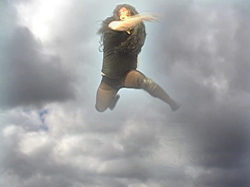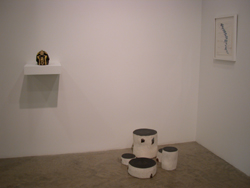
|
||
|
Portland art blog + news + exhibition reviews + galleries + contemporary northwest art
|
||
All I Want is Everything at small A Small A project's inaugural exhibition, All I Want is Everything, gives us a taste of what we should expect more of in the coming months. The exhibition is tastefully spare and features work by a savvy group of young artists based in cities from LA to NYC who are just beginning to find their way onto the pages of ArtForum, Trans> and Modern Painters. At least half of the artists in the show will have larger shows throughout the next year. The premise of the exhibition - artists who explore the potential of transcendent or transformative experience in rock and roll / metal - isn't a particularly new or revolutionary curatorial thesis, but the show is smartly enacted. After the Savage Gallery closed its doors at the end of last summer, its former gallery director Laurel Gitlen took over the location to begin her own gallery. Gitlen made her mark at the Savage Gallery by bringing in artists like Dave McKenzie and co-founded Portland's first art fair in 2004 with former PICA curator Stuart Horodner. Both at Savage and through the Affair, Gitlen has consistently brought in artists from Brooklyn and elsewhere outside of Portland, which has raised the hackles of at least some of the art community here, but is exactly why I'm glad she's continuing with her latest endeavor at small A projects. Themes of transformation and transcendence are potentially weighty, but given a dose of pop culture irreverence, they are rendered facile. It's all intentional of course, a strategy of a contemporary art scene always willing to undercut its own authority. To make an obvious metaphor, it's a bit like your favorite nostalgia-inducing song - its formulaic predictability is also what makes it rock.
Rooted in the well-trod territory of art about music and music culture, most of the work in the exhibition is particularly focused on the issue of how persona is crafted through a cultural vocabulary derived from rock and roll. Capturing all that is trite and transcendent about the self-indulgent posturing of the performer onstage, Josh Mannis' Master of the Immortal Arts anchors the show. His lo-tech video draws from the best parts of early video art, showing the artist as death metal star, complete with a headbanger's wig of long curly locks, repeatedly leaping into the air, an ominous, percussive beat punctuating his movement. The scene takes place in front of a backdrop of rapidly moving clouds. It's a bit tribal (a la Olaf Breunning) and a bit new age, perfectly capturing the performer in the climax of his art. Several works in the show serve as relics from specific subcultures. Amy Sarkisian's beaded skulls combine Goth morbidity with kitsch craftiness. A fascination with the potential for beauty in dark scenarios is apparent in Craig Doty's black and white photos of fire, through which vague body-like forms can be discerned. Mannis' composite black and white photo, an elaborate Victorian photoshop composition filled with the pop mysticism of drug culture, serves as a kind of mandala for stoners and rockers. In the work of Erik Hanson, songs act as autobiographical signposts. His sculptures serve as relics signifying key moments in his life. One drawing shows a branch filled with blooming orchids who are each named by a song title, symbolizing his coming out as mediated through a growing obsession with disco music. Entrenched in a testosterone laden club culture as a punk rock DJ, Hanson's closet love of disco music led to questioning and acknowledgement of his own sexuality. The relationship between the transformative and the trite become blurry, as the profound manifests itself through the details of pop culture. Hanson's tree stumps imagine the rings of Joy Division and Sex Pistols LPs as tree rings, a testament to music as a marker of time. It's very much in the realm of LA-based artist Dave Muller, who creates geological maps based on top ten lists and paints ultra-realistic renderings of worn LP spines chronicling the top ten lists of named subjects. Zoe Crosher also shares an interest in how the persona of her subjects are mediated through the self-conscious adaptation of music subcultures. In her series One Year Later, young women are shown before and after their first year of college. Pink Floyd posters and changing fashion sensibilities attest to the link between music culture and self-transformation. Michael Bise's pencil drawing of a 3am domestic bedroom scene resembles indie cartoons and look in a more generic way to the small signs that reveal sub-culture affiliations. Barb Choit overtly acknowledges the commercialization of music culture. The subjects of her long group portraits, drawn in a breezy illustrative style, are culled from promo shots of obscure and emerging bands, mostly found from internet sources. She considers her drawings an attempt to document, if not immortalize, bands who may not be around for more than a few years. Her drawings act as a very sincere tribute to these bands (it should be noted she's in underground band The Organ) while revealing the posturing and mechanics of the commercial enterprise that these musicians are involved in. All I Want is Everything closes on Sunday, but tonight you can get your glam on at the closing party, where director Todd Haynes will be on hand to introduce a screening of his 1998 film Velvet Goldmine. Closing Reception • November 4 • 7-10p (film begins at 8p) Posted by Katherine Bovee on November 04, 2005 at 10:47 | Comments (0) Comments Post a comment Thanks for signing in, . Now you can comment. (sign out)
(If you haven't left a comment here before, you may need to be approved by
the site owner before your comment will appear. Until then, it won't appear
on the entry. Thanks for waiting.)
|
| s p o n s o r s |
 |
 |
 |
 |
 |
 |
 |
 |
 |
 |
 |
 |
 |
 |
 |
 |
 |
 |

|
Site Design: Jennifer Armbrust | • | Site Development: Philippe Blanc & Katherine Bovee | |




